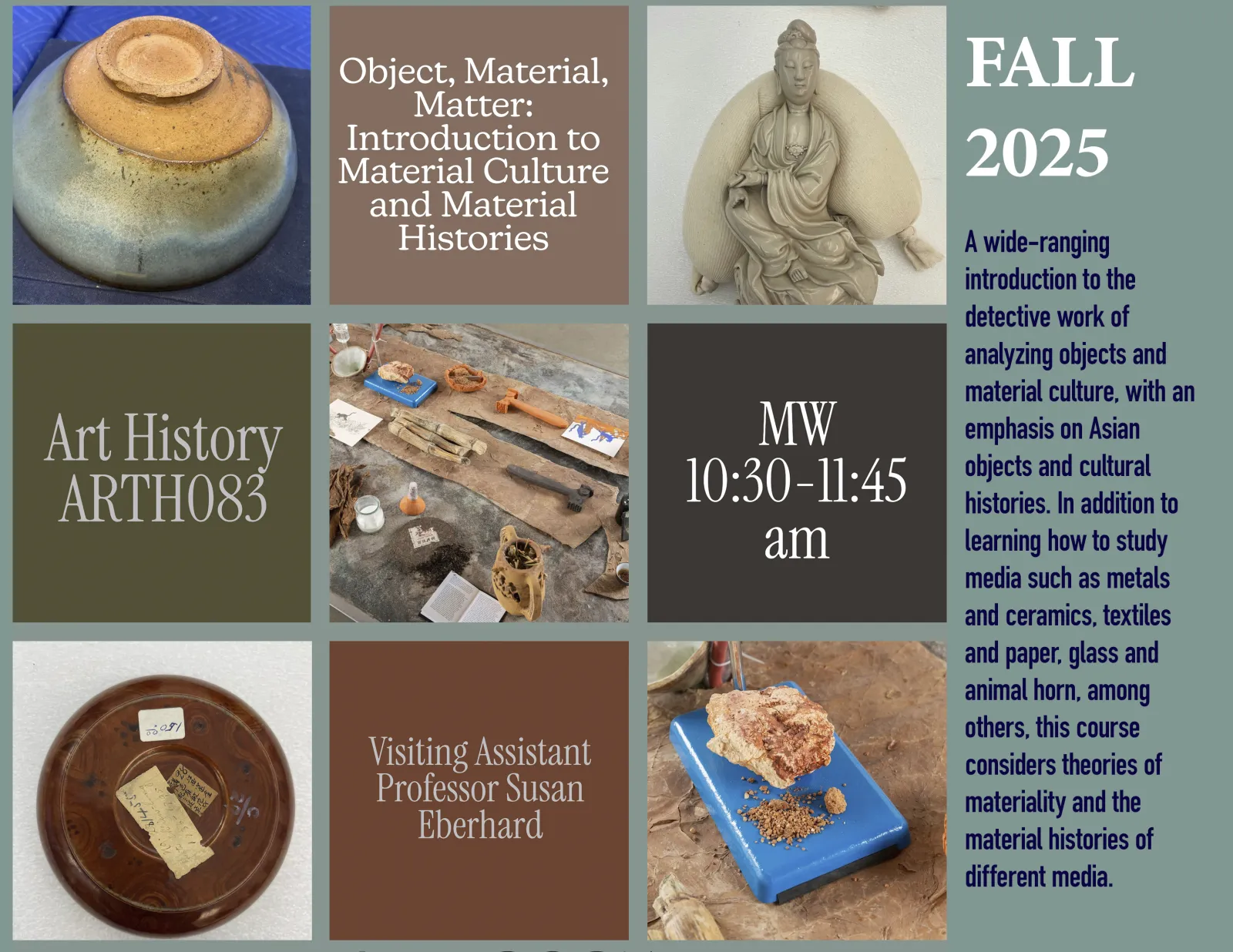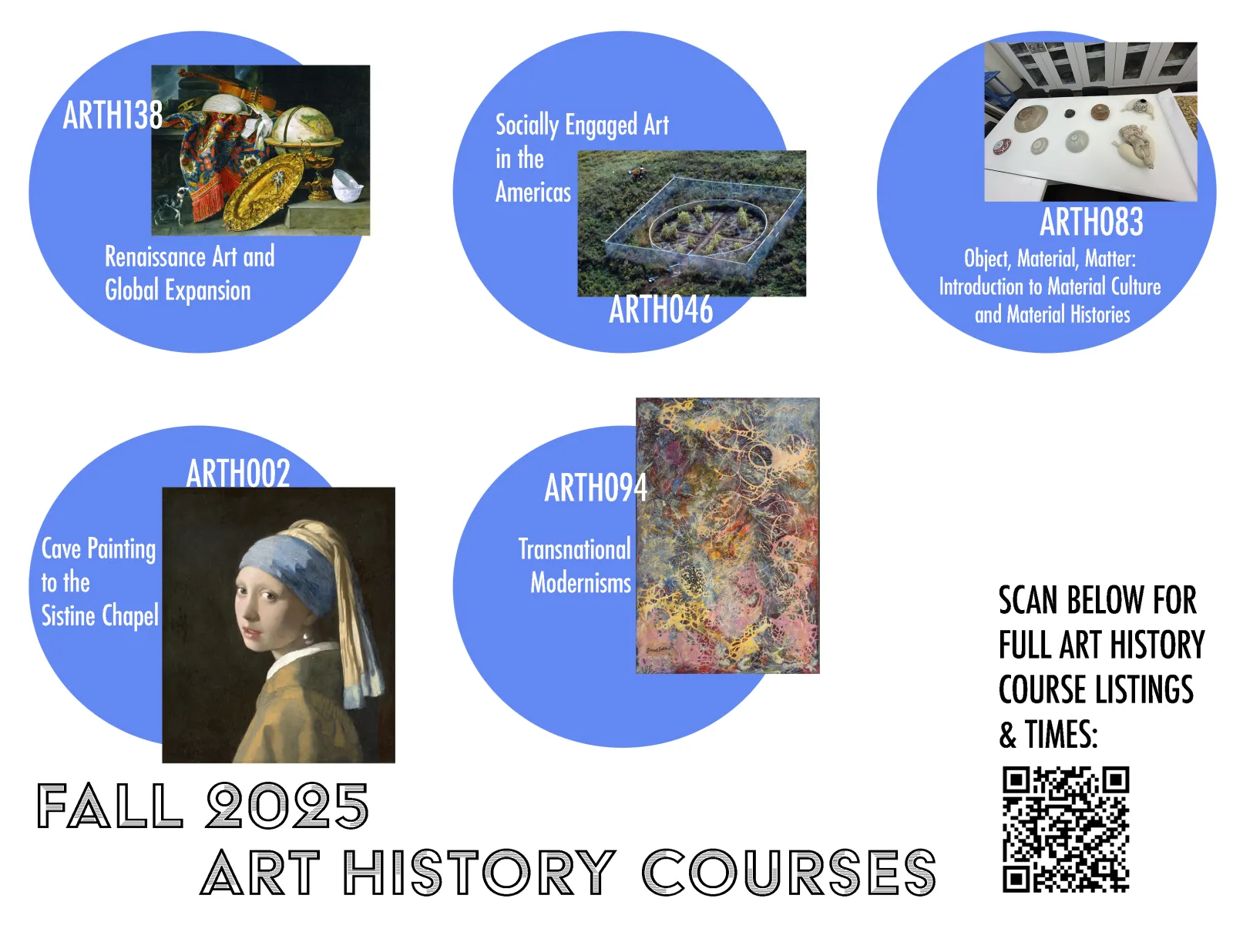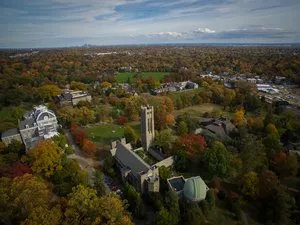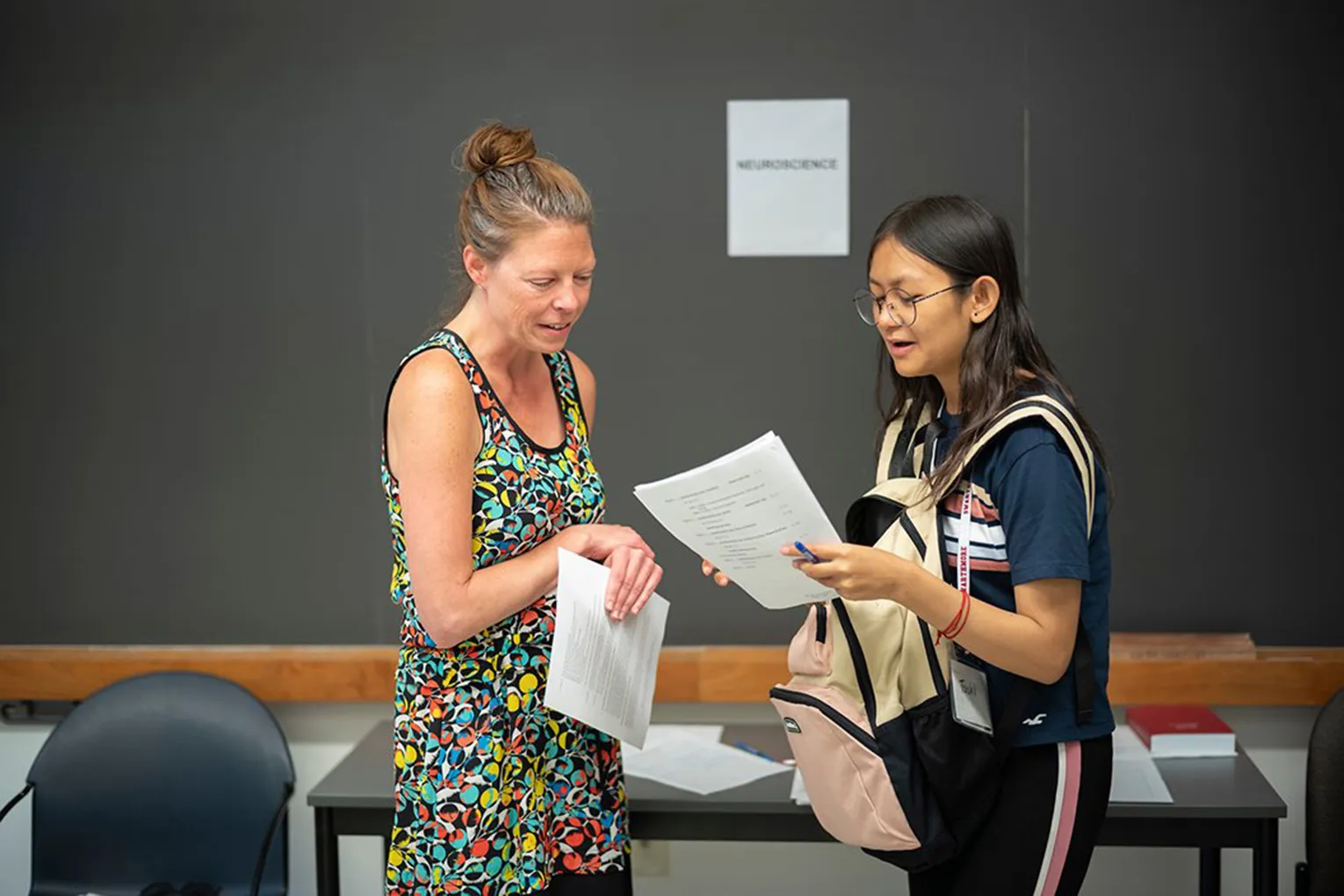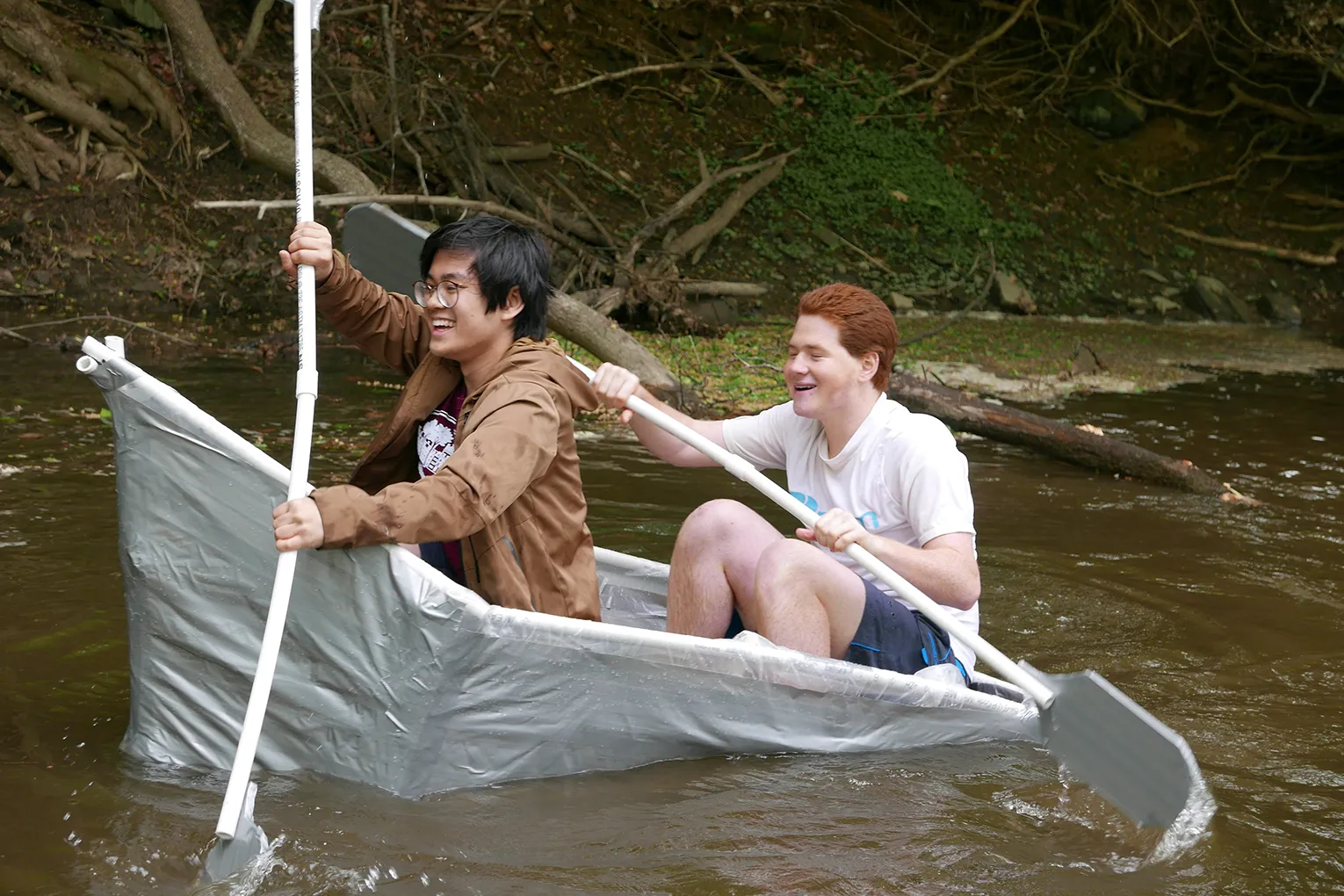Fall 2025
-
ARTH 001N. First Year Seminar: Indigenous Art, Land, and Environment.
-
Cross-Listed: ENVS 002
-
This first year seminar introduces students to the ways that Indigenous art and cultural traditions center diverse relationships to the environment, land, and place. This course will examine how Indigenous artists of the Americas model and visually express a relationship to place as something inhabited equally by human and non-human beings across present and ancestral time. Throughout this seminar, we will examine maps, land art, monuments, and other visual material through an expanded field, considering other practices such as beading, pottery, and carving alongside contemporary Indigenous art as expressions of land relations that reframe the mainstream history of Euro-American art and environmentalist movements. Students will be asked to consider and evaluate art and the present landscape in terms of colonial histories, ancestral timescales, and changing Indigenous traditions, including a critical evaluation of the land and place upon which Swarthmore College is situated. This writing course will introduce students to forms of art writing such as the art review, the personal response essay, cartographic interpretation, and the research paper.
- Green.
-
-
ARTH 001S. FYS: Uncovering Philadelphia's Asian Art
-
Eligible for ASIA, ASAM
-
An exploration of Philadelphia's often-overlooked engagements with Asia through art, architecture, material culture, and sites. This course introduces methods for visual and object-based analysis, and examines how the visual dimensions of local history can illuminate the tensions of global connections.
- Eberhard.
-
-
ARTH 002. Cave Painting to the Sistine Ceiling
-
This course is an introduction to the Western tradition of art and architecture as developed in the Mediterranean, Egypt, and Europe from prehistoric cave painting through the seventeenth century. The goal of this course is to provide you with a chronology of the major works of art and architecture from this period and to teach you the vocabulary and methodologies necessary to closely analyze them. In addition to considering works of art and architecture in terms of the material, historical, and cultural circumstances in which they were produced, we will analyze the concept and history of the "Western tradition" itself. A full range of issues related to the production and reception of artworks will be examined in this course, including: the representation of-and construction of-race, gender, class, religion, social relations, and politics; the use and status of materials; the context in which these works were used and/or displayed; and the critical responses these works elicited.
Note: This course is an Introductory Survey Course
- Reilly.
-
-
ARTH 046. Socially Engaged Art in the Americas
-
Can art change the world? Questions about the impact of art in the social fabric are constitutive of the idea of avant-garde art. This course will introduce students to these debates as they took shape in the American continent since 1960. With an emphasis on forms of art practice that outspokenly seek to provoke positive social change, this class provides a parallel narrative of contemporary art, in which art exits the museum space to ingrain itself in broader social processes.
During the semester students will learn about different theories of socially engaged art articulated by artists and art historians alike. We will consider art as activism in the Civil Rights era, forms of artistic resistance to Latin American military dictatorships, second wave feminist art, contemporary community-based art, and forms of engaged art practice concerned with planet-wide environmental crisis. We will debate the tactics and ideals guiding these practices, and we will evaluate the potential risks that come with relying on art for social transformation. This course alternates short lecture periods with in-class discussion of primary and secondary sources. It is structured around six thematic blocs, at the end of which students will produce a short written assignment.
- Checa-Gismero.
-
-
ARTH 065. Land Back!: Visual Expressions of Global Indigenous Sovereignty
-
Cross-listed: ENVS: 056B
-
The "Land Back" movement is an Indigenous-led campaign that in recent years has emerged as a prominent focal point for establishing Indigenous political authority over territories once claimed and controlled by Indigenous nations. This course examines how Indigenous artists and activists have expressed "Land Back," or sovereignty over land, culture, and representation, in visual and material forms across time. It will consider Land Back and decolonization movements within a history of generational efforts to reestablish Indigenous sovereignty over ancestral territories around the world, and seek to understand how cultural expression imagines, shapes, and informs debates around return and sovereignty. It will examine the intertwined nature of Indigenous arts, land rights, and issues such as environmental protections, land loss, and language; material expressions of place-based knowledge; cultural property laws such as NAGPRA; the relationship between federal and state recognition and arts, crafts and copyright laws; and global Indigenous sovereignty movements.
- Green.
-
-
ARTH 067. Building Architecture from Dirt to Dust
-
This course will offer a history of architecture not as a history of styles or historical periods but as an account of building, making, and constant remaking. Starting from the production of materials from which we construct architecture and ending with the decline, deterioration, and afterlife of structures, this discussion-based course will offer a chance to reflect on the labor that constructs the built environment and the many people who are involved in its production from the very beginning to the very end. Beyond the architect, we will also consider the role of miners and manufacturers, finance capital, labor unions, construction workers, users and renovators, maintenance staff, and those involved in deconstruction and resale. Over the course of the semester, we will come to understand architecture as constructed by many hands, largely outside of the control of the principal architect, and involving many forms of design.
- Goldstein.
-
-
ARTH 083. Object, Media, Matter: Introduction to Material Culture and Material Histories
-
A wide-ranging introduction to the detective work of analyzing objects and material culture, with an emphasis on Asian objects and cultural histories. In addition to learning how to study media such as metals and ceramics, textiles and paper, glass and animal horn, among others, this course considers theories of materiality and the material histories of different media.
- Eberhard.
-
-
ARTH 094. Transnational Modernisms
-
This discussion-based course, applies a transnational lens to study the development of artistic modernisms during the Cold War. In this course, students will learn the theories and forms of avant-garde art production in a world shaped by the ideological competition between the United States and the Soviet Union. Departing from an examination of how these tensions materialized in New York and Moscow, students will examine how this polarized climate impacted as well artistic production in Western and Eastern Europe, Latin America, Africa, Asia, and the Middle East, setting the foundations of a transnational sphere of artistic circulation that anticipated the globalization of art at the turn of the century.
- Checa-Gismero.
-
-
ARTH 138. Renaissance Art & Global Expansion: Honors Seminar
-
This Honors seminar focuses on Europe's relations with Latin America, Africa, Asia, and the Middle East in the early era of colonization and global expansion. Students will explore what the visual arts can reveal about the transfer of ideas and the growth of global trade and cultural/religious conflict in this era of increasing internationalism. We will focus on cross-cultural exchange in the 15th and 16th centuries, and consider these issues primarily from the European perception of the expanding world. The theme of globalism will be addressed through the lens of painting, sculpture and architecture, and through objects that are not typically considered "high art" such as maps, textiles, festival art, and ceramics.
- Reilly.
-
-
ARTH 181. Independent Study
-
Independent Study: Crafting Kin: A Year of Socially Engaged Art
By inviting social practice artists for a series of workshops and programming, Crafting Kin: A Year of Socially Engaged Art will foster a culture of dialogue and mutual aid among students and the Swarthmore community. Learning from others, the project invites us to think creatively and collectively about how to resist difficult historical times. Held on Mondays over lunch, the workshops series fosters community among students and introduces us all to longstanding models of collaboration among art and culture workers. Students will propose and execute a series of socially engaged art projects.
- Checa-Gismero.
-
Spring 2026
-
ARTH 001J. First Year Seminar: Arts of Everyday Life
-
Centered on the study of five artworks, this first year seminar introduces students to the interconnectedness of art and everyday life. The course traces the parallel histories of feminism and art in US modernity. Students of this seminar will study the work of women who relied on art to make sense of their everyday experience and fight for a more inclusive art world. At the end of this writing course students will have produced forms of art writing such as the art review, the personal essay, the wall caption, and the research paper.
- Checa-Gismero.
-
-
ARTH 003. Asian Art: Past and Present
-
This course surveys the arts of China, Korea, Japan, and India from the late Neolithic period to the present. Using vocabularies and tools of analyses from the discipline of art history, we examine the form and significance of key monuments of art and architecture, consider the dynamic relationship between the visual arts and their ritual, religious, economic, and socio-political contexts, and reflect upon parallels between past and present motivations for cultural production.
Note: This course is an Introductory Survey Course
- Eberhard.
-
-
ARTH 029. Architecture and Urbanism of Philadelphia
-
Swarthmore sits amidst a hall of fame of architectural and urban history. This course turns to this history not simply to understand the architecture of one important metropolitan area, but to understand how these examples can teach about broader themes including the history of city planning, the industrial and urban revolutions, the search for "American" architectural styles, metropolitan growth and urban renewal, the ascent of modernism, the emergence of postmodernism, and historic preservation, among others. Students will learn both foundational methods of architectural history as well as many of the major movements that have constituted it. This course will be taught in Philadelphia as part of the Tri-Co Philly Program.
- Goldstein.
-
-
ARTH 051. Renaissance Florence and Environs
-
This course will consider the art and architecture of Renaissance Florence. In addition to studying the works of artists such as Brunelleschi, Donatello, Botticelli, Leonardo, and Michelangelo, we will consider a full range of issues related to the production and reception of artworks. Topics will include patrons and their agendas, the construction of artistic identity, artists' rivalries, the role of art in the domestic sphere, the use of art as propaganda, the education of the artist, and the source, meaning, and use of materials.
- Reilly.
-
-
ARTH 074. Histories of Photography
-
This course surveys the history of photography from the announcement of photography's invention in the nineteenth century to the end of the twentieth century. It traces the development of the medium as a form of artistic expression and as means of visual communication, highlighting how photographic images, practices, and discourses have not only informed but also changed our perception of the world around us. We examine the varied meanings of photography within specific social, historical, cultural contexts as well as through different methodological lenses across disciplinary divides, reflecting on the countless ways through which photography bound itself to modern life.
Note: This course is an Introductory Survey Course
- Eberhard.
-
-
ARTH 076. Art Museums: History, Theory, Controversy
-
Museums are public institutions that collect, preserve, document, exhibit and interpret material objects for the benefit of the public. This course examines the history of museums, modes of collecting, and attempts to preserve different visions of the past. It will consider how art museums reveal the social and cultural ideologies of those who build, pay for, work in, and visit them. It will also examine the complicated relationship between the history of art and museum acquisitions, curatorial practice, and exhibition strategies.
- Reilly.
-
-
ARTH 080. Black Art In and Out of the Museum
-
Cross-List: BLST 009
-
This course introduces students to the history of black art and the representation of blackness in the American museum. Black art has been at various times excluded from, segregated within, and problematically embraced by museums. Black artists, curators, and activists have found ways to challenge these institutions' racial politics, while also creating networks, models, and venues for showcasing black artists' works and processes to their communities of concern. This class will take stock of this history and its relationship to the current moment of recognition black artists face.
- Batts.
-
-
ARTH 100. Senior Capstone
-
This course is open to and required of senior majors in art history and is the culminating research experience in the major. Students will write a substantial research paper over the course of the semester based on their previous coursework and interests. Weekly meetings will focus on developing the project step-by-step; learning about research methodologies from the instructor, other department faculty, and staff; and workshopping in-progress writing with classmates. Successful completion of the Senior Capstone fulfills the senior comprehensive requirement for Art History. This is a designated writing course.
- Goldstein.
-
-
ARTH 160. Global Contemporary Art: Honors Seminar
-
What is 'Global Contemporary Art'? Since the end of the Cold War contemporary art has experienced a phenomenon of rapid planet-wide expansion. Over 600 art fairs and biennial exhibitions structure a network where artworks, art professionals, and ideas circulate periodically, informing a community that is simultaneously autonomous from and connected to local art scenes. In these last three decades, art as previously practiced in Europe and the United States has expanded to acquire planetary visibility. Simultaneously, traditions of art making from other world regions have been welcomed -albeit in altered fashion-, into the central stages of the artworld. As historians, artists, and critics: How do we make sense of this shift? More importantly: How do we fit in this picture?
In this Honors seminar students will learn about the institutional, epistemic, and sociopolitical processes involved in the formation of 'global contemporary art' as an art historical category. We will study the role that exhibitions, academia, and the art market play in the setting of artistic trends, while we analyze how these influences materialize in the practice of artists around the globe. During the semester students will engage with primary sources such as artworks and artists writings, and secondary sources from the art industry and academia alike. At the end of this course, students will be ready to describe the political, economic, and cultural processes active in the globalization of the art industry since 1990, and reflect on the consequences of this process in academic, practiced, and curatorial approaches to contemporary art.
- Checa-Gismero.
-
-
ARTH 181. Independent Study
-
Independent Study: Crafting Kin: A Year of Socially Engaged Art
By inviting social practice artists for a series of workshops and programming, Crafting Kin: A Year of Socially Engaged Art will foster a culture of dialogue and mutual aid among students and the Swarthmore community. Learning from others, the project invites us to think creatively and collectively about how to resist difficult historical times. Held on Mondays over lunch, the workshops series fosters community among students and introduces us all to longstanding models of collaboration among art and culture workers. Students will propose and execute a series of socially engaged art projects.
- Checa-Gismero.
-
Fall 2026
-
ARTH 001M. First-Year Seminar: Leonardo
-
Leonardo da Vinci was a great anatomist, engineer, architect and inventor whose drawings circulated around the courts of Europe. In this discussion-based course we will study the inventions, writings, paintings, drawings and biographies of this important Renaissance artist. We will consider the ways in which the works, biographies, and myths of Leonardo have been analyzed (and created) over the centuries. In doing so, we will develop a critical understanding of the methods and terminology of the discipline of art history itself.
- Reilly
-
-
ARTH 001N. First Year Seminar: Indigenous Art, Land, and Environment.
-
Cross-Listed: ENVS 002
-
This first year seminar introduces students to the ways that Indigenous art and cultural traditions center diverse relationships to the environment, land, and place. This course will examine how Indigenous artists of the Americas model and visually express a relationship to place as something inhabited equally by human and non-human beings across present and ancestral time. Throughout this seminar, we will examine maps, land art, monuments, and other visual material through an expanded field, considering other practices such as beading, pottery, and carving alongside contemporary Indigenous art as expressions of land relations that reframe the mainstream history of Euro-American art and environmentalist movements. Students will be asked to consider and evaluate art and the present landscape in terms of colonial histories, ancestral timescales, and changing Indigenous traditions, including a critical evaluation of the land and place upon which Swarthmore College is situated. This writing course will introduce students to forms of art writing such as the art review, the personal response essay, cartographic interpretation, and the research paper.
- Green.
-
-
ARTH 010. Art and Climate Change
-
Eligible for ENVS.
-
In this introductory level seminar students will learn how changing conceptualizations of nature have shaped the genealogy of art in Euro-American modernity. Special emphasis will be placed on the strategies developed by contemporary artists to make sense of the unfolding climate crisis.
- Staff.
-
-
ARTH 013. Ancient Greece and Rome
-
This course will examine the art and architecture of ancient Greece and Rome, highlighting how certain artistic and architectural traditions were used by political powers to control the population and to provide the basic infrastructure of civilization. Topics will include: the changing image of the human figure; mythological narratives and their iconography; the development, canonization, and diffusion of architectural forms; the integral role of images in the day-to-day religious and domestic practices of ancient people; and the turn from a Classical visual world to a Christian one.
- Reilly.
-
-
ARTH 061. Art and Culture of Indigenous Philadelphia: From Shackamaxon to the Present
-
Cross Listed with (ENVS 056)
-
For millennia prior to the signing of the "Great Treaty" by William Penn and Chief Tamanend of the Lenape under the Treaty Elm at Shackamaxon, Indigenous peoples have played a central role in the history of Philadelphia and the art and material culture of theregion. This course will examine the visual and material histories of Indigenous communities, artists, and leaders of present-day Philadelphia and its surrounding ancestral territories, from pre-contact to the present. We will consider the history of the city and the land upon which it stands as an Indigenous place, one that has been occupied since time immemorial by Indigenous peoples and that has served as a gathering place and cross-roads for the travelers, diplomats, and storytellers of many Native nations. We will consider how the Indigenous history of Philadelphia and Pennsylvania more broadly reflects on and is interrogable through present-day sites and constructions of civicidentity, and how to this day a resurgent Indigenous community calls Philadelphia home. Among topics for close study are the archaeologyand material culture of the Eastern Woodlands and ancestral Lenape territory, including earthworks, mounds, and their environmentalrelations; Euro-American representations of Indigenous peoples and the landscape from early contact through the nineteenth century, including important scenes in the city's history such as Benjamin West's Penn's Treaty with the Indians and portraits of Indigenous leadersand diplomats passing through the city as part of delegations to the nation's capital in Washington, DC; Indigenous oral histories of andvisual representations of such histories, such as the Shackamaxon wampum belt; monuments and the memorialization of colonial history; and modern and contemporary Indigenous art and exhibitions that reflect Philadelphia as vibrant urban Indigenous center.
- Green.
-
-
ARTH 066. Colloquium: Race, Space, and Architecture
-
This colloquium considers how race and identity interact with architectural and urban spaces, especially in the United States in the twentieth century. By studying the historical and theoretical dimensions of topics including the meanings attached to public and private housing, the training and practice of designers, and the reconstruction and transformation of urban places, we will interpret how race has shaped buildings, landscapes, and plans. In turn, we will also examine how the built environment has shaped the formation and interpretation of racial categories.
- Goldstein.
-
-
ARTH 084. Asia/Americas: Art Across the Pacific, 1571 to Today
-
This course examines the art and visual-material culture produced out of cultural encounter between Asia and the Americas, starting from the founding of Manila in 1571, spanning histories of imperialism and migration in the Pacific, and ending with Asian American and diasporic art.
- Eberhard.
-
-
ARTH 154. Art of Modern China: Honors Seminar
-
This honors seminar explores modern Chinese art and visual-material culture, focusing on creative engagements across the profound changes of the nineteenth and twentieth centuries-a period that spans China's final imperial century, its tumultuous development into a modern nation, and its emergence on the global stage as a single-party state. How did creators (artists, craftspeople, designers, etc.) navigate foreign invasions and domestic uprisings? How did they experiment with new technologies, contribute to reform movements, and launch new types of popular culture and entertainment? How did they participate in revolution and collectivism, and negotiate the rise of post-socialist state power? Across this period, how did art intersect with the environment on issues such as famine, resource extraction, and state-sponsored development? Finally, how did notions of modernity in China operate in tension with China's past and present, Westernization, and the larger Asia-Pacific context?
In closely studying the field of modern Chinese art history, the course examines key artists, industries, and movements, the impact of political, social, and technological developments, and major debates and issues. By studying works across media in tandem with primary sources, we consider how creative concerns engaged with seismic transformations over the last two centuries.
May be taken for one credit with permission of instructor.
- Eberhard.
-
Spring 2027
-
ARTH 001J. First Year Seminar: Arts of Everyday Life
-
Centered on the study of five artworks, this first year seminar introduces students to the interconnectedness of art and everyday life. The course traces the parallel histories of feminism and art in US modernity. Students of this seminar will study the work of women who relied on art to make sense of their everyday experience and fight for a more inclusive art world. At the end of this writing course students will have produced forms of art writing such as the art review, the personal essay, the wall caption, and the research paper.
- Staff.
-
-
ARTH 005. Modern Art in Europe and the United States
-
This course surveys Western European and American art from the late 18th century to the 1960s. It introduces significant artists and art movements in their social and political contexts and also focuses attention on art historical approaches that have been developed to interpret this art, including socio-economic and feminist perspectives.
Note: This course is an Introductory Survey Course
- Green.
-
-
ARTH 008. Built Ecologies: Architecture, Landscape, and Environment in East Asia
-
A thematic introduction to approaches to building and landscape in East Asia, this course stresses environmental connections (from the ecological to the extractive) while also examining East Asian notions of nature (from the philosophical to the ideological).
- Eberhard.
-
-
ARTH 026. Painting, Chemistry and Conservation
-
Cross-Listed: CHEM 003B.
-
This interdisciplinary course explores the intersection of chemistry with the visual arts. During the course of the semester we will learn about the materials available to artists, issues faced by museum curators and conservators, and some basic chemistry concepts related to these topics. Our exploration of the chemistry, and history, of art media will include labs that extend and enhance the lecture topics. Does not fulfill NSEP requirement.
- Reilly.
-
-
ARTH 040. Michelangelo to Mussolini: The Classical Tradition in Rome
-
This course considers how artists and patrons in Rome (and beyond) imitated, reinterpreted, and challenged the classical tradition of art and architecture-and to what ends. I will first provide students with a foundational knowledge of the Greco-Roman tradition and then we will analyze how artists and architects from the Renaissance to the twentieth-century employed this tradition to promote the agendas of popes, bankers, kings and dictators. For the final project, students will analyze an example of how the "neoclassical" project took form in other countries, such as Germany, Russia, England and the United States.
- Reilly.
-
-
ARTH 048. 20th Century Latin American Art
-
This introductory course exposes students to the histories, theories, and forms of modern art in Latin America in the 20th Century. The course explores the development of artistic scenes in the continent, and how avant-garde art practices have engaged a variety of nation-building programs -either as reinforcements or as refutations. During this course students will become familiar with scholarship and critical frameworks formulated in Latin America, as well as in the United States.
Note: This course is an Introductory Survey Course
- Staff.
-
-
ARTH 072. Global History of Architecture: Prehistory to 1750 CE
-
This survey will provide an introduction to the history of the global built environment from the earliest human settlements to the middle of the second millennium. Chronologically and geographically broad, we will examine selected works of architecture and urbanism from diverse cultures around the world, commencing ca. 10,000 B.C.E. and ending around 1750 C.E. In doing so, we will interpret the built environment as both a product of its social, political, and cultural contexts and a force that shapes those contexts. Despite a diversity of examples, common themes--such as cultural interaction and exchange, religion and belief, transmission of knowledge, architectural patronage, spatial and aesthetic innovation, and technological transformation--will emerge across the course.
Note: This course is an Introductory Survey Course
- Goldstein.
-
-
ARTH 100. Senior Capstone
-
This course is open to and required of senior majors in art history and is the culminating research experience in the major. Students will write a substantial research paper over the course of the semester based on their previous coursework and interests. Weekly meetings will focus on developing the project step-by-step; learning about research methodologies from the instructor, other department faculty, and staff; and workshopping in-progress writing with classmates. Successful completion of the Senior Capstone fulfills the senior comprehensive requirement for Art History. This is a designated writing course.
- Eberhard.
-
-
ARTH 153. Modern Architecture and Urbanism: Honors Seminar
-
This honors seminar examines the broad array of designed and built works, makers, sites, and texts that constitute modern architecture and urbanism. Students will interpret the many facets of modernism through key historical readings-both primary and secondary, canonical and revisionist; analysis of examples; and consideration of their makers, both well-known and less so. A guiding assumption is that modernism was never only one thing and had different-even sometimes opposite-intentions, manifestations, and consequences in different contexts. Yet we will follow one persistent question as a link across the semester: how did modern architects and urbanists seek to create a better world? The motivations behind and answers to this defining question of modernism were never consistent across our period of study. While centering designed objects, then, we will interrogate how people have experienced modernism differently, depending on their identities, subject positions, geographic locations, and social roles.
- Goldstein.
-
